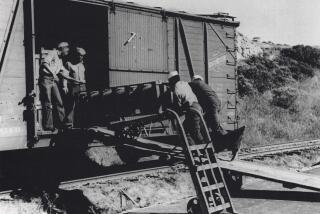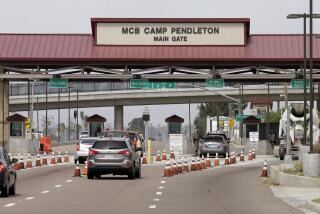Report Clears Navy in Fatal Shipwreck
- Share via
SAN DIEGO — A yearlong investigation by the U.S. Coast Guard failed to determine the cause of a shipwreck off San Clemente Island that left a San Diego fisherman and his crewman dead, but it did conclude that it probably was not a result of Navy shelling.
The officer in charge of the investigation of the February, 1986, wreck of the Cindy Faye said Tuesday that he concluded that “the most likely probable cause” was that the boat became disabled in heavy surf and was driven onto rocks.
Lt. Robert Murray said he found insufficient evidence to support allegations by the family and friends of skipper Boyd Reber that the boat was blown up by a U.S. Navy explosive, possibly fired during Navy gunfire practice on the other side of the island.
“The vessel did come ashore, which is a significant finding,” said Murray. “Because if you’re talking an explosion or something like that, a vessel that explodes isn’t going to float ashore intact.”
The shipwreck, which resulted in the deaths of Reber, 38, and Frank Germano, 21, of San Pedro, is the subject of $10.8-million wrongful-death lawsuit against the Navy filed by Reber’s widow last summer in federal court.
The suit alleges that the men died Feb. 25 in an explosion of either a missile or live ordnance. It accuses the Navy of negligence in failing to warn the fishermen of danger and in allowing explosives to strike their boat.
Reber and Germano were last seen Feb. 21 when they set out from San Pedro in Reber’s 36-foot fiberglass fishing boat. Ten days later, a fisherman spotted Reber’s body floating about 20 yards off San Clemente Island. Germano’s body was found the next day.
Murray said Tuesday that he was unable to reach an unequivocal conclusion because there were no surviving witnesses and no “good hard evidence” indicating what happened. However, he made the following findings:
- Most of the wreckage, including the main engine and heavy hardware, washed up on the beach. If there had been an explosion, he said, those items would not have floated ashore.
- Other fishermen reported that the surf was surprisingly heavy. Murray said Reber might have been caught by a wave and been unable to get his engine started in time to avoid the wreck.
- Any shelling would have taken place six miles away on the south side of the island. Murray said the missiles would have had a range of 2 1/2 miles and would have had to go over a mountain to reach the Cindy Faye.
- Murray said a large bent piece of metal that Reber’s friends cite as evidence of an explosion could have been bent when the boat crashed on the rocks.
- The bodies of the victims “didn’t show that they primarily had suffered an explosion,” Murray said. Reber died of drowning and although Germano died of lacerations to his lungs and liver, Murray said he could have suffered a crushing blow when the vessel rolled over.
Asked about the allegation that Reber’s net might have picked up some unexploded ordnance, Murray said, “Even the Navy couldn’t rule out there being unexploded ordnance after 40 years of activity out there. But the damage to the vessel and where the evidence was found didn’t support that.”
More to Read
Sign up for Essential California
The most important California stories and recommendations in your inbox every morning.
You may occasionally receive promotional content from the Los Angeles Times.










